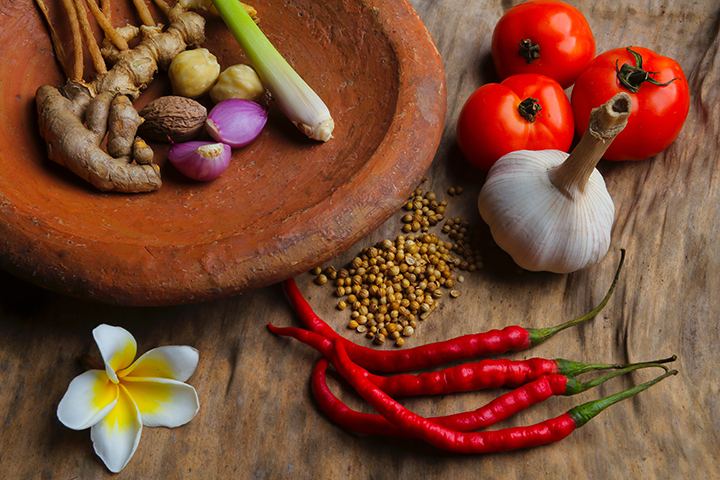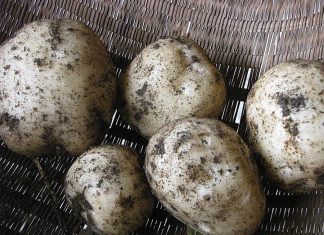 |
|
| Issue #64 • July/August, 2000 |
Whenever you discuss peppery issues like religion or politics your emotions and blood pressure are at risk of running high. This is because the conversation is likely doomed to end in dispute. In like manner, when chili lovers gather to debate who makes the best chili con carne, arguments over religion and politics can seem tame. The casual mention of chili can put a glisten in the eyes of those around you as they ponder the secret ingredient or magical technique that makes their chili superior to all others. All it takes is for someone to make an innocent statement like, “You should try my new chili recipe, it’s the best you’ve ever tasted.” And that euphoric gleam in the eyes of those around him or her is likely to vanish and resurface as the gargoyled, irresistible passion known as Chili Mania.
This Jekyll and Hyde-like transformation can turn mild-mannered conversations into heated feuds. On occasion, these feuds have erupted into knockdown, drag-out fights. Even references to and definitions of this simple but elegant dish never seem to be casual and without emotion. Chili has been defined as “a dish made of shredded cattle to which powdered chili peppers have been added” and “an incendiary dog food widely eaten in Texas.” One Mexican dictionary, not happy with the reference that chili may have Mexican roots, defines the dish as a detestable food with a false Mexican title sold in the United States from Texas to New York.
On the other hand, chili lovers express their feelings in very different terms. Referring to his beloved Texas-style chili, the great musician Harry James once said, “Next to jazz music, there is nothing that lifts the spirit and strengthens the soul more than a good bowl of chili.” Will Rogers described his favorite chili as “the bowl of blessedness.”
If you ask 10 knowledgeable cooks to define a hollandaise sauce, the universal answer will most often be, “An emulsified sauce consisting of butter, egg yolks, and lemon juice combined with a little water, salt, and cayenne pepper.” If you eliminate any of these ingredients, make substitutions, or fail to follow a specific preparation procedure your sauce becomes something else. None of these cooks will argue this point.
But if you ask the same 10 cooks for a definition of chili con carne, the only element they will come close to in agreement is: a spicy stew-like dish with a reddish color. Of course, if there is a green chili lover in the group, there will be dissent.
Why is this? I don’t profess to have all of the answers, but in my opinion this is due to the fact that outside of a few broad ingredient guidelines that define color, piquancy, and loose preparation specifications no one seems to know what chili is. Is it a stew, a soup, or a casserole? Con carne means with meat. If this is true, how can anything vegetarian be called chili?
Over the years I have eaten chili or creations called chili that have been made from a broad range of ingredients including tofu, tuna fish, cheese, and rice. One so-called vegetarian chili contained collard greens, fava beans, and okra. I believe that chili is one of the very few stew-like concoctions that everyone, regardless of experience, can make using these broad and loose guidelines. The lack of clear definition and precise production procedure has made it possible for all of us to be chili experts.
So, in a subjective way we can all look upon our chili creations as being superior to all others. Without these unique characteristics chili would not have several worldwide societies and newspapers devoted solely to the appreciation of its infinite interpretations. If there was only one true chili, there would be no need for chili cook-offs and chili cookbooks. Have you ever heard of, or attended, a hollandaise sauce cook-off? That would be a real snoozer.
The history of chili
There is a fair amount of scholarly argument over the history of chili. The story has so many twists and tangents that it is almost impossible to sort the facts from the exaggerations, conflicting claims, and downright lies. Some of the most unlikely stories trace chili as far back as the 16th century. One of these legends states that a young nun from Castile, Spain, suddenly started going into trances that left her body lifeless for days. When she awoke from these trances she claimed that her spirit had been in a far away land where she preached Christianity to the Indians. Sister Mary Agreda is supposedly mysteriously known to some Indians of the southwestern United States as the “lady in blue.” Unsubstantiated claims have been made that she wrote down the first chili recipe for the Indians during one of her mysterious visits. The problem with this fable is the fact that long established cultures, like those of Native American’s, have culinary practices that seldom change from one generation to another. There is no tangible evidence that chili became part of the Native American diet during that time.

Another more believable notion, based more on historical fact than legend, indicates that the first recognizable chili-type stew was created by Texas adventurers and cowboys during the 1840s. Before heading into the California gold fields or a big cattle round-up, it is said that these hardy, inventive people pounded dried beef, fat, salt, and wild chili peppers into a pemmican like paste that was easy to carry and relatively shelf stable. This paste, or chili-brick, was then boiled with water while on the trail to make a hearty, hot meal. However, it appears that this “chili pemmican” was not widely accepted in Texas or elsewhere for more than two decades. During my research I was unable to find any evidence of Texas soldiers eating chili during their Civil War campaigns.
It seems as though chili did not really become a popular food in Texas, or anywhere else, until the late 1800s when it became a standard menu item in Texas prisons. Also, the colorful women nicknamed the San Antonio “chili queens” started selling their chili brews from bubbling cauldrons in the downtown plazas, including the Alamo plaza, this in an attempt to make summertime roadkill protein taste betterjust kidding.
Prison cooks in Texas and other parts of the Southwest discovered that the chili pepper, when combined with certain spices and herbs, could work wonders with inferior cuts of meat. In Texas, jailhouse chili was so popular a dish that former inmates, from time to time, wrote to prison systems requesting the recipe, claiming that they could not find a chili as good on the outside.
In San Antonio, Texas, many felt that a night was not complete without a visit to one of the popular chili queens. Every night, around dusk, these picturesque vendors would spice up the night when they set up their crude tables covered with checkerboard-patterned oil skins. Each chili queen also set up a large ornate lamp and dressed gaily to attract the eyes of customers who had been drawn to the plaza by the wonderful chili scent. The chili queens remained a popular attraction in San Antonio until 1943 when government sanitation standards enforced in the town’s restaurants were applied to them. Of course, it was impossible for these portable, outside eateries to comply with these rigid standards and they quickly disappeared. Fortunately, by that time, chili was well on its way to becoming one on the most popular dishes in Texas and across the rest of the country as well.
No reflection on chili history, even a brief one such as this, is complete without the mention of some additional milestones that have enhanced the ever-growing love that inventive cooks have for this fundamental yet convoluted food. Many chili cookbooks dismiss commercial chili powder as a stale mystery mix made with questionable ingredients that produces a bad tasting chili. However, one of the reasons that chili became so popular during the 1890s was the invention of the first chili powder seasoning mix. Prior to this, home cooks found that preparing chili peppers for cooking and seasoning purposes was, and still is, an arduous and sometimes painful task.
The invention of chili powder by one of two men living in different parts of Texas opened the Chili Mania door to many home cooks. It is generally agreed among dedicated chili lovers that one or both of these men deserve a place in history close to Alfred Nobel, the inventor of dynamite. If you live in the Fort Worth area of Texas your vote would go to De Witt Clinton Pendery. Pendery arrived in Fort Worth in 1870 and set up a successful grocery store. When the store burned down in 1890 he started selling chili pepper pods and spices for making chili and tamales. To enhance sales for his new business he created a well accepted powdered chili pepper, oregano, cumin seed, and garlic blend that he called “chilo-maline.” This powder is still made and sold by a company that bears his name. Folks in the San Antonio area, however, give credit for this invention to William Gebhard of New Braunfels, Texas, now a suburb of San Antonio. Gebhard sold his chili powder blend under the Eagle Brand Chili Powder trademark. This original formula is still used to make this wonderful spice blend, and is also sold by a company that bears his name.
The first gourmet organization dedicated to the love of chili, the Chili Appreciation Society, was founded in 1947. Now called the Chili Appreciation Society International (CASI), it has chapters all over the world. Oh (expletive deleted), I just remembered that I forgot to renew my membership.
Unfortunately, the strict rationing imposed during World War II removed chili con carne from many restaurant and home menus. During the late 1960s two events helped to revive the popularity of chili in this country. The most significant was the first publication of a book written by the well known historian of the Southwest, chili lover and cook Frank X. Tolbert. It’s called A Bowl of Red. Shortly after that book appeared, it became widely publicized that President Lyndon B. Johnson was also a chili lover. The combination of these two happenings fostered a chili popularity explosion.
During the autumn of 1967, Frank Tolbert and his friends contrived a tongue-in-cheek marketing plan to promote his new book. They organized America’s first chili cook-off.
This prankish event was held in Terlingua, Texas, a patch of desert with a moon-like geology near the big bend of the Rio Grand River. The contest originally pitted the chief cook of CASI, Wick Fowler, against Dave Chasen, the well known Beverly Hills restauranteur and personal chili chef to Elizabeth Taylor. It is well known that Texans and Californians look on each other’s chili formulas with disdain. Unfortunately, Chasen became ill just before the contest and the organizers were forced to find a new opponent. Fortunately for them, H. Allen Smith, a popular humorist from Mt. Kisco, New York, had just written an article for Holiday Magazine titled Nobody Knows More About Chili Than I Do. The article lambasted Texas-style chili, and it probably would have been totally ignored by Texas chili cooks, but the marketing value of this matchup was too rich to ignore. Wick Fowler, the Texas chili hero, against the Eastern bad-mouth was a contest made in heaven.
After some bantering back and forth between Smith and Tolbert, Smith accepted the challenge and the first annual World Chili Cook-off was on. Even though the event ended in a tie under very bizarre circumstances, it started a national infatuation with the bowl of red that continues to this day.
Every year there are thousands of chili cook-offs in every corner of this country to which enthusiastic chili cooks travel thousands of miles to participate. Chili is a gastronomical wonder-food that has risen from simple beginnings to almost mythical status. It has been the official dish of the state of Texas since 1977 and there is an active contingent of chili lovers lobbying to make chili con carne the official dish of the United States. This is quite an achievement for a food that is one of the least defined of all dishes.
Can anyone make chili?
I have often said that good chili can be made by anyone, regardless of culinary experience. This does not mean that making chili is simply a matter of mindlessly rummaging through the kitchen gathering an assortment of ingredients and tossing them into a pot with a little liquid and turning on the heat. There a few simple and easy-to-follow rules, but they are rules that must not be violatedunless, of course, you’re into feeding stray dogs, mice, and rats. And I believe that there are three basic types of chili: good, bad, and dog food.

In San Antonio, Texas, many felt a night was not complete without a visit to one of the popular chili queens. |
Good chili is possible when all of the ingredients in the pot agree with each other, that is, every ingredient in the pot serves to compliment all of the others in quality, taste, texture, and aroma.
Bad chili is obviously the opposite. An example of bad chili is adding zucchini squash to the pot, then cooking the chili for two hours, or adding a cup of salt to the pot when all you needed was a teaspoon.
Dog food is just about any canned chili.
Before we move to the recipe section, let’s spend a few moments reviewing some chili basics.
Chili basics
The heart and soul of this wonderful “stew” that we call chili con carne is the chili pepper. For me, the chili pepper is the main attraction. Chili is one of the few foods that provides a stage for the varied and subtle flavors of the capsicum pepper so that it can be put on display for all to recognize and appreciate. When first introduced to chili peppers, the first sensation that the newcomer experiences is the heat caused by the chemical capsaicin. Capsaicin is concentrated in the oil contained in various parts of the pepper. The highest concentration is in the seeds and the veins. But most of the pepper’s flavor is concentrated in the pulp, that part of the pepper lying just under the outer skin. These wonderful and varied flavors are, without a doubt, the richness that makes good chili good.
There are over 300 varieties of chili peppers and each has its own unique flavor and heat value. Not all chili peppers are widely used to make chili con carne, but there are a few that the aspiring chili maker must be familiar with.
Another definition for good chili is one that people will eat and enjoy. The types of chili pepper used will be a significant factor in the finished taste and piquancy of any chili. So it is necessary to have a basic knowledge of which chili peppers are hot, which are mild, and what kind of flavor, if any, they will contribute to the finished stew. What follows is a list and description of a few chili peppers often used to make chili. The chili peppers that I talk about here are all purchased and used in dry form. I live in southern New England where the growing season is not long enough for many chili peppers. So the selection of fresh high quality chili peppers is slim for most of the year. When I make chili, I use a variety of dried chili peppers to create the central flavor. Fortunately, there are some specialty shops in my area that carry a good selection of these dried peppers, and most are of high quality. A couple of these stores even take special orders for peppers they don’t usually stock. Using these dried peppers, I have developed several custom chili pepper seasonings.
Here is a descriptive list of a few dried chili peppers that I use most often in these seasonings.
Cascabel: This is a medium hot Mexican pepper that is almost never found fresh in this country. When dried the pepper is round like a cherry pepper with a translucent skin. It has a dark reddish-brown color and the seeds rattle around inside, hence its name cascabelor jingle bell. When toasted this pepper develops a rich nutty flavor.
Chipotal: Any pepper that is dried by a smoking process can be called a chipotal. However, the jalapeno is most commonly used for chipotals. Jalapenos do not dry well by other methods. Usually only mature jalapenos are selected to be smoked-dried, making them significantly hotter than the immature green pepper. When used to enhance the flavor of a chili, they impart a wonderful, but not at all subtle, smoky flavor to the stew.
Ancho: This is one of the most popular dried peppers used to make chili in this country. When fresh it is called chili poblano. It has a brownish-red to chocolate color and is about 4 inches long and 2½ inches wide. It has a rich chili flavor with a hint of raisin and, because it is a rather mild pepper, it can be used in quantity to add a deep rich flavor to any chili creation.
Mulato: The mulato is a close cousin to the ancho. When dried it is difficult to distinguish from an ancho. However, there are distinct differences between the two. Both peppers dry flat and become blackish brown and very wrinkled. Each will show its true identity when soaked. The ancho rehydrates to red, while the mulato retains its chocolate color. The mulatto also has a chocolate-like flavor and is sweeter, richer, and more pungent than the ancho. An old fishing buddy of mine enhanced many of his chili creations by adding two ounces of pureed mulato to the pot about 15 minutes before he removed it from the heat. This gave his stew a wonderful rich flavor with a subtle hint of chocolate. My wife, Tricia, suggests that adding a little bittersweet chocolate to a chili comes close to duplicating this flavor. As strange as this may sound, try it, it works.
Pasilla: This is a long, narrow, curved pepper that turns a wrinkled, dark-raisin color when dried. The pasilla has rich, mellow flavor and is slightly hotter than the ancho but with none of its sweetness.
New Mexico: The darling pepper of New Mexican chili lovers, it is a light green when young, matures to a medium green, and finally a deep red when left on the bush. In the fall, chili pepper fanatics throughout the Southwest crowd roadside roasting stands to stock their freezers with the new fall crop. I am most familiar with the dried mature version of this pepper but depending on where you live, it is also available fresh and smoked dried while still green. Its heat range is from medium to hot, depending on the cultivar, and it has a very distinctive flavor. I have more to say about this interesting pepper in the recipe section.
Chiltepin: This is a native pepper that grows wild in the lower part of the Southwest and throughout Mexico and it is devilishly hot. Seasoned asbestos mouths love this tiny ovoid-shaped pepper and seldom cook anything without adding a measure of these little fireballs to the recipe. On occasion, I am able to buy a dried cultivated version at a specialty food store in my area. I buy enough to fill a 14-ounce cocktail sauce bottle about two-thirds full. I then fill the bottle with dry sherry and leave it in the refrigerator for a couple of days to stew. I use a couple of teaspoons (a little goes a long way) to jazz up chili, soups, sauces, and anything else that I think needs a little zing. If you can find a seed source, this pepper does well when grown in pots. Unlike many other chili peppers it prefers partially shaded locations.
The first time I tasted this pepper I was in a little restaurant in Mexico. It appeared as a dollop of reddish paste on the side my salad plate. I asked the waiter what it was and what I should do with it. He told me that it was salad seasoning, and I should pour a little oil on my salad and gently mix the seasoning into the salad. Ay Caramba! That is a salad I will never forget. Just be aware, if you are fortunate enough to find some of these peppers, use caution. You must be prepared to take responsibility for your own pain.
As you know there are many other varieties of fresh and dried chili peppers, but most of these, in my opinion, have little to add to a good pot of chili con carne. Oh yes, I know there are many of you who cherish your cayenne, fresno, habanera, scotch bonnet, serrano, and other worthy peppers and may not agree with me. It’s your chili and you are the executive chef, so use what you will.
Choosing a meat
The backbone of good chili is meat. Many purists believe that the only meat for chili is beef. A growing number of cooks, myself included, hold that other meats, such as chicken, lamb, pork, and venison also work well. I have yet to use such meats as buffalo, water buffalo, moose, emu, ostrich, and elk. But if you have special knowledge of cooking game meats, you may find them interesting in your chili pot.
When using beef or any other red meat don’t waste money on high-priced steaks, chops, and roasts. Lean cuts of beef chuck, fresh brisket, bottom round, or round steak are perfect meats for chili. Pork shoulder, Boston butt, or shoulder end pork loin roast are also good chili cuts. All of these cuts should be trimmed of excess fat. Remember that toughness in the meat is not an issue when making chili. After an hour in the pot tough meats that have been properly prepared will become tender.
There are several ways to prepare meat for the chili pot, depending on the type of meat you intend to use. When I use beef and have a lot of energy, I dice the beef into half inch cubes. More frequently I will use beef that has been course ground or, as insiders say, “chili ground.” A meat is considered chili ground when it is put through the grinder using a ½ or 1-inch cutting plate. These are the same cutting plates that butchers use when making some varieties of ethnic sausages. Chili ground beef is fast becoming a regular item in supermarket meat cases. If you don’t see it, ask the meat cutter. Often he or she will run a batch through the machine while you wait or take a special order to be processed later. When using pork or chicken I simply dice it into ½-inch cubes. Your chili deserves only the best quality ingredients, so avoid “on sale” cuts of meat that are often loaded with sinew and excess fat.
Choosing spices
When it comes to spices and herbs, as I have said so many times before, “The fresher the better.” You don’t have to use a large variety of flavor enhancers to make a good pot of chili. In fact there are only a few herbs and spices that have enough savor to keep from getting lost in the presence of the almighty chili pepper. Here is a list of several spices and a couple of herbs that will enhance the flavor of any chili.
Cumin: The musky, nut-like flavor of white cumin seed is what gives chili its distinctive flavor. The flavor of cumin becomes more pronounced when the whole seed is roasted in a dry skillet or in the oven before it is ground. Chili connoisseurs use this simple roasting technique with many of their spices and herbs.
Coriander: Coriander seed is one of the first spices to be used by man. The seeds have a strong, nutty aroma and a sweetish, pungent taste. The word “coriander” is derived from the Greek koris, meaning bed bug. This is because the ancient Greeks believed that the leaves and the seeds smelled like that insect. There are almost as many definitions of its flavor and odor as there are interpretations of chili con carne. Its aroma has been likened to orange peel, lemon peel, and a mixture of cumin and caraway. Also, the bed bug thing has never gone away. Like cumin, it is best to buy the whole seed and grind it as needed.
Garlic: Since I have been writing for Backwoods Home Magazine I have said a great deal about my affection for this wonderful herb. The only thing left to say about garlic is that it is one of Nature’s greatest gifts to the cook. Having plenty of fresh garlic in stock is a must staple for the chili cook’s pantry.
Whole clove: Clove has a sharp pungent taste and a fragrant aroma. In ancient China etiquette demanded that anyone received by the emperor must have a clove in his or her mouth to sweeten the breath. I believe that a small amount of clove added to a pot of chili enhances the aromatic quality of the stew.
Allspice: Allspice is one of the principal ingredients in Jamaican jerk seasoning. It is one of the spiciest and most versatile flavor enhancers on the planet. Allspice is an aromatic spice that was created to be forever wed to the chili pepper. When the whole berry is toasted, ground, and added to a pot of chili, the marvelous fragrance and taste of this stew will forever linger in your memory of good food experiences.
Oregano: Many of the folks who profess to know their “chili fixin’s” claim that Mexican oregano is a must for seasoning chili. Any other dried herb, according to them, is only dead leaves when used to season chili. Well, in my opinion, this is one of the most whimsical concepts that exists in chili theory. Which variety are they talking about? The Botanical Garden at the National University of Mexico says that there are 13 varieties of oregano growing in that country. It is true that Mexican oregano has a more pronounced flavor than its unrelated counterpart, Greek oregano, but I believe that both of these herbs, if understood and used properly, will complement a good bowl of chili.
The herb that we call Greek or European oregano is a close relative of sweet marjoram. It is quite hardy and will grow in a broad spectrum of weather and soil conditions. Sweet marjoram, on the other hand, thrives only in the area close to the Mediterranean basin. Mexican oregano, or wild marjoram, comes from a different plant family than Greek oregano and is native to Puerto Rico as well as Mexico.

The author testing one of his chili creations |
The reasoning that many chili experts use to support the “Mexican oregano only” theory is its strong taste and pungent aroma will not get lost in a stew as spicy as chili. This is true, but I think that limiting this quality to just this one herb is overkill for a couple of reasons. First of all, not all varieties of Greek oregano are created equal. Chefs in southern and western France have discovered that growing oregano in barren soil in sun drenched locations dramatically increases the flavor. What gardener can’t effect the same conditions? More important is the fact that many of us would be hard pressed to tell what type or oregano was used in a finished pot of chili. I have discovered that adding a measure of sweet marjoram to my base chili seasoning, along with the Greek oregano, adds additional character to my chili, and the character of both herbs does not get lost. Having said that, I hope that my membership renewal in CASI is not rejected.
Fat or no fat
There is no escaping the fact that animal fat imparts more flavor to all foods than vegetable fat. Many of us still hold to the notion that the best chili is made with a lot of fatusually kidney suet, salt pork, or bacon drippings. I prefer a small amount of rendered, dry cured salt pork to sauté vegetables and meat. However, the older I become, the more concerned I become about clogged arteries, heart attack, and stroke. But I also believe that a chili cooked in the absence of fat is missing a great deal of flavor. So I allow my chili to cook to completion without skimming. When the chili is done I let it cool in the refrigerator to congeal the fat so I can easily remove most of it before reheating. Though I suggest using vegetable oil in all of the recipes, you can substitute an equivalent amount of animal fat of your choice.
Beansyes or no?
Beans are a natural mate for chili. So isn’t rice. Tricia, my wife, prefers to add fresh stewed beans to her chili. I like eating chili with the beans served on the side. The whole family loves rice with chili and both beans and rice provide a pleasant contrast, in both texture and flavor, to any chili. They also help stretch a small amount of meat a long way. If you are going to add beans to your chili while it is cooking, I suggest you use dried beans that have been soaked and slow-cooked according to the directions on the bag. If you don’t want to deal with dried beans, buy good quality canned beans and rinse them well before serving. Goya Foods packs a large variety of high quality canned beans. All of these beans have a pleasant taste and a firm texture.
Alcohol
Alcohol seems to leech the subtle chili pepper flavors from a pot of chili. Before adding any beer, ale, wine, or other liquor to your stew, cook it for a few minutes in a separate pot to vaporize the alcohol.
Special equipment
All you need is a five-quart or larger pot with a heavy bottom. I use one of my Dutch ovens. Leave the lid in the cabinet. Chili is at its best when slow cooked in an uncovered pot.
So much for the basics. Let’s cook some chili.
Chili seasoning as a concept
In India many dishes are seasoned with Marsala powders. A marsala powder is a blending of spices and herbs usually custom designed for a particular dish. There are five basic marsala powders that I am familiar with. Each of these powders has hundreds of individual interpretations, depending on the flavor the Indian cook is attempting to impart to his or her creation. Marsala powders are formulated to allow the cook to customize a dish with the addition of extra herbs and spices, without compromising the basic character of the dish. Borrowing from this effective blending technique I developed a basic chili seasoning that I use to enhance a wide variety of dishes.
The all-purpose version of this seasoning appears in the Nov./Dec. 1999 issue of Backwoods Home Magazine. The following version is formulated just for making chili. Of course, just like any other seasoning mixture, the ingredient selection and amounts are open to individual interpretation. Many serious chili lovers would recoil at using cloves, coriander, and allspice in a chili seasoning. If you are one of these, eliminate these ingredients and substitute whatever. The key to success with this seasoning is using high-quality dried peppers, whole spices, and fresh dried herbs.
In this seasoning I use the well known New Mexican chili, a pepper that has been cultivated in New Mexico for over 300 years. A cattle rancher from Oxnard, California, introduced the seeds to his home state and eventually started a pepper cannery in Anaheim, California. The first cultivar of these original New Mexican seeds was renamed the Anaheim chili. Today many cultivars of this pepper are sold by seed suppliers with names like Anaheim M, Anaheim TMR 23, Big Jim, Colorado, New Mex, and New Mexico No. 9, just to name a few. Dried New Mexican or Anaheim peppers are often used to make the wreaths and ristras that you see in the produce section of your local supermarket. I first fell in love with this chili after eating a side order of fresh green New Mexican peppers that were stuffed with cheese, chopped olives, and minced jalapenos. They had been batter-dipped and deep-fried. The restaurant called these little dandies Fire Crackers. In the Southwest they call them chilies rellenos. This mild chili, in my opinion, has a subtle, rich flavor that is completely different from other chilies and perfectly suited as a flavor enhancer for the recipes that I intend to share with you in this issue. However, most of my chili creations demand heat, so to complement the mild flavor of the New Mexican I have added a fairly hot pepper that has very little flavor of its own, chili De Arbol. I also use this pepper in many Thai recipes when heat is the only complement that is necessary to round off the flavor of a dish. I have further enhanced the chili mixture with the medium-hot, nutty flavor of the Cascabel pepper. Sweet Hungarian paprika is added to enhance the traditional red color of the finished chili. If these peppers are not to your liking, substitute peppers that are.
Next to chili peppers and cumin, oregano is about the most important flavor enhancer used in chili. As I said, many self-proclaimed chili experts use only Mexican oregano, an herb with a strong dry pungency that is sniffably different from its European counterpart. Since I live in an area where Mexican oregano is a scarce commodity, I use a combination of European oregano (this is the type commonly found on the store shelf) and sweet marjoram to create a flavor that satisfies my taste buds. Once you have prepared and sampled this formula, you can customize it to suit your personal taste. This seasoning will keep for months when stored in the freezer.
Ingredients:2 oz. dried New Mexican chilies, seeds and stems removed 6 dried De Arbol chilies, seeds and stems removed 6 dried cascabel chilies, seeds and stems removed 1 Tbsp. whole cumin seed, toasted
|
½ Tbsp. whole coriander seed, toasted
|
Method:1. After removing the stems and seeds from the chilies, break them into pieces. Toast them over low heat in a heavy-bottom skillet until they are fragrant, slightly darkened, and somewhat crisp. Do not walk away from this procedure, and stir the peppers frequently while they are on the heat. Transfer the toasted peppers to a heat-resistant dish to cool. 2. Using the same procedure described in the previous step, lightly toast the cumin seed, coriander, whole clove, and allspice berries. Set the spices aside to cool. 3. In a spice mill, coffee grinder, or blender reserved for grinding spices, process the peppers into a fine powder. Repeat this process with the toasted spices. 4. Combine the powdered chilies and spices with the leaf marjoram, oregano, and Hungarian paprika 5. Pack the finished seasoning in an airtight container and keep it stored in the freezer.
|
|
|
||
This is a recipe I developed to test the integrity of my chili seasoning. With the exception of the chocolate, salsa, and the brown ale, all the ingredients are standard to a basic chili con carne. The salsa was my son Michael’s idea. He was given his own cookbook for Christmas and in less than six months he has developed some strong opinions about recipe construction. As I stated above, adding the chocolate is my wife’s idea. The beef stock and ale amounts are approximations. Feel free to play with these two ingredients. The amount of liquid added and the total cooking time will determine the thickness of the finished stew. We think this is a great chili for several reasons. First of all, it won’t blow your head off or make your stomach feel like it is under a termite attack. You can eat a whole bowl of this stuff without stopping to cool off. And finally, it has a lot of chili flavor, while the tomato flavor is almost nonexistent. Also, if your taste and texture preferences run along the same lines as does my wife’s, please feel free to add beans. Your preferences rule. This recipe serves six to eight. |
||
Ingredients:6 Tbsp. peanut oil 3 lb. lean ground beef chuck, chili grind 1½ lbs. lean pork, cut into thin strips about 1 inch long by ½-inch wide 2 medium yellow onions, diced 6 garlic cloves, diced fine 4 Tbsp. chili seasoning
|
1 16-ounce jar chunky salsa, medium or hot 1 14½-oz. can low-fat beef stock 1 12-oz. bottle brown ale, precooked to boil off the alcohol 1 28-oz. can crushed tomato in puree 1 oz. bittersweet chocolate salt and pepper to taste |
|
Method:1. Heat two tablespoons of oil in a heavy-bottom skillet or Dutch oven. Add the ground beef and sauté over medium-high heat until the meat loses its pink color and starts to brown. When making chili, I don’t feel that browning is an important factor. If you disagree with me, add your beef in small amounts and brown it as you wish. If you brown the meat in small amounts, you will need more oil than I have suggested. Remove the cooked beef and hold it in a suitable size bowl or other container. 2. Heat two tablespoons of oil in the same pot and sauté the pork over medium-high heat until it loses its pink color and is browned to suit your taste. Add the cooked pork to the beef. 3. Heat the remaining two tablespoons of oil and sauté the onions over medium heat until they become translucent and start to brown. If you have the patience to bring your onions to an even light brown color, it will add a pleasant light sweetness to your chili. 4. When the onions are done add the garlic and continue to cook the mixture for about 30 seconds. 5. Add the chili seasoning and continue to cook the mixture for another 30 seconds. 6. Add the salsa, beef stock, pre-cooked ale, and crushed tomato to the pot and heat the mixture to a slow, even simmer. Gently stir in the meat and return the stew to the same slow even simmer. Cook the chili for 1½ to 2 hours. 7. Add the chocolate during the last half hour of cooking. Salt and pepper to taste. 8. If at any time during the cooking the chili seems too dry for your taste, add more liquid of your choice. I serve this chili with a side of stewed pinto beans or Texmati rice. My wife and daughter often crumble pilot crackers over their chili.
|
||
|
||
|
The first serious “chili head” I ever met was my old fishing buddy, Howard. Howard was a member of an elite group of Cape Cod fishermen that made a living during the summer months fishing the surf and Cape Cod Canal for striped bass, blue fish, and tautog (sometimes called blackfish) and selling them to selected restaurants. Howard also supplemented his income cooking on a per diem basis at a couple of these restaurants. He loved to cook over a campfire, a talent that made him a natural sand dune cook for a group of enterprising market fishermen. These guys followed the tide changes and migrating fish from Scusset and Sagamore Beaches to Race Point Beach, often fishing without rest for 24 hours or more. When it came time for them to eat, the food had to be hot and in sufficient quantity to satisfy several very big appetites. To meet this challenge, Howard developed several campfire specialties. One of these was a basic chili recipe that he served in a wide variety of ways. To him, chili was more than a favorite food; it was a culinary experience. Unlike many other beach-front cooks, Howard looked upon most canned foods, especially chili, with disdain. He prepared his chili from scratch using the finest ingredients he could buy. He once held up a can of chili and read the label: “This stuff is a foul mixture of mystery meats, caramel color, calcium chloride, dehydrated onion and soy protein, held together with modified food starch.” As he lowered the can he added, “When sales are slow the factory changes the label from chili to dog food.” This aversion to canned chili, however, is where Howard’s chili purism ended. He developed several interesting ways to prepare and serve his chili. The recipe that follows is, without question, a favorite of all who taste it. Howard, like me, used a pre-prepared custom chili seasoning in all of his chili recipes. “I don’t have the time to mess with chili pods and spices on a windy beach at night,” he would say. The following recipe for chili pinwheels is one that Howard usually made after he finished his restaurant shift. He would then store them in the restaurant’s freezer until he needed them. The fishermen would toast them over the hot coals and eat them with a variety of Howard’s homemade sauces. His recipe combines a special, easy to prepare chili formula with a flaky biscuit dough. These delicious pinwheels can be served with almost any sauce that you can think of. My recipe review committee (my children Sarah, Jason, and Michael) like them topped with homemade BBQ sauce, but I like a simple brown sauce as well.
|
||
Ingredients:2 lbs. lean ground beef (80 or 85 percent lean is best, regular grinddon’t use the chili grind for this) 8 oz. onion, diced fine 3 oz. celery, diced fine 3 cloves of fresh garlic, diced fine
|
2 Tbsp. chili seasoning 1½ cups canned tomato sauce 1 Tbsp. masa harina or fine corn meal salt and black pepper to taste biscuit dough (recipe follows) |
|
Method:1. In a large heavy-bottom skillet or Dutch oven, sauté the ground beef over medium heat until it loses its red color. Drain off the fat. Add the onions and celery and continue to cook until the beef is completely cooked. Add the minced garlic and chili seasoning and continue to cook the mixture for one minute, stirring constantly. 2. Heat the tomato sauce in a small heavy-bottom pot, stir in the corn meal, and cook this mixture over low heat for one minute. 3. Add the tomato sauce mixture to the beef mixture in the large skillet or Dutch oven. Simmer this mixture for five minutes over low heat. Transfer the mixture to a large, shallow casserole dish, cover and refrigerate overnight. 4. The next day prepare the biscuit dough according to the biscuit recipe that follows. 5. On a floured board, roll the dough into a rectangle approximately 12 by 25 by ¼-inches. Place the chilled chili mixture into the center of the dough and spread it evenly to about ½ inch from the edges. Moisten the edges of the dough with a little milk. Roll up the dough from the longer (25-inch) side. Seal the edges when the roll is complete. Pat the roll lightly with floured hands to shape it evenly. 6. Lightly coat two cookie sheets with vegetable shortening. 7. Using a very sharp knife, slice the roll into disks about 1 inch thick. 8. Space the disks evenly on the cookie sheets and bake in a preheated 425-degree oven for 25 minutes or until the pinwheels turn a golden brown. Serve immediately with your favorite sauce.
|
||
|
||
Ingredients:3 cups all-purpose flour 1½ Tbsp. double acting baking powder ¾ tsp. kosher salt
|
6 Tbsp. butter, margarine, or shortening 11/8 cups buttermilk |
|
Method:1. Sift the flour, baking powder, and salt together in a mixing bowl. 2. Cut the shortening into the flour until the mixture becomes grainy. 3. Add the milk and stir into the flour mixture just enough to make the grains stick together and form a soft dough. Turn the dough onto a floured surface and knead lightly for about 30 seconds. The dough is now ready to roll.
|
||
|
||
|
Here is a light and flavorful chili that was created by my three children, Sarah, Jason, and Michael, with a little help from my wife, Tricia. I was determined to prove that it isn’t necessary for one to be a dedicated chili head or experienced cook to make a good chili. Tricia is an accomplished cook, but has seldom made a chili from scratch or developed a chili recipe. The only experience my three children had with chili was from bowl to mouth. To set the stage for this unusual event I decided to make a fresh batch of chili seasoning with the help of the kids. I will describe the adventures and surprises of this session in an upcoming issue on children in the kitchen. After we finished the seasoning I asked everyone to think of the ingredients they would like to use if they were making a special chili for themselves. Tricia volunteered to write down all of the suggested ingredients and help the kids put together a recipe using as many of the ingredients as possible. My contribution was the chili seasoning and marjoram. Tricia suggested the chicken and determined the amounts of the individual ingredients. Jason and Michael searched the refrigerator vegetable bin and came up with the onion, bell pepper, and garlic. Sarah has developed a love for hot and spicy foods and she insisted we include a can of tomatoes with hot chilies. She also figured out how much chicken broth would be necessary to maintain the proper amount of moisture in the stew. We all voted together on the type of beans. I lost.
|
||
Ingredients:8 oz. dried, red kidney or pinto beans (I like pinto beans, everyone else prefers red kidney) cold water to soak the beans 2 Tbsp. peanut oil or other light oil 2 lbs. boneless, skinless chicken breasts diced in ½-inch pieces 1 medium onion, diced medium 1 large red bell pepper, diced medium
|
2 cloves fresh garlic, minced 2 tsp. chili seasoning (I wanted more, but was overruled by the group) 1 tsp. McCormick Grill Mates Montreal Chicken seasoning ½ cup chicken broth 1 10-oz. can diced tomatoes with chilies 1 tsp. dried marjoram |
|
Method:1. Soak the beans for six to eight hours in enough cold water to cover the beans by two inches. 2. Drain the beans and discard the soaking water. Rinse the beans in cold running water. In a suitably sized pot cover the beans with enough fresh water to cover them by 2 inches. Over medium heat simmer the beans until they are tender and fully cooked. Drain the beans immediately and set them aside. 3. Heat the oil in a Dutch oven or other heavy-bottom pot over medium heat. Add the chicken and sauté until it loses its pink color. Add the onion, bell pepper, and garlic to the chicken and continue to cook the mixture until the chicken is fully cooked. 4. Gently stir in the chili seasoning and chicken seasoning. Continue cooking the mixture for another 60 seconds. 5. Stir in the chicken broth, diced tomatoes, and marjoram and slowly simmer the chili, uncovered, for 20 minutes. 6. Gently fold in the beans and simmer the chili for another two or three minutes, just long enough to heat the beans. 7. Serve immediately with your favorite warm-from-the-oven corn bread or over rice.
|
||
Well, amigos, you now have the basic art of chili making as seen by Dick, Tricia, Sarah, Jason, and Michael. Let us know what you think of our creations and please share some of your chili ideas and concepts with us.














